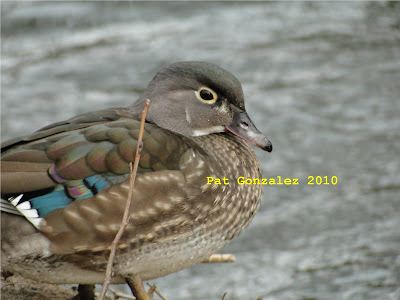
There's a new twist in Tulsa when it comes to just what Kay and Jay Red-tail are up to this season. Jackie Dover of the Tulsa Hawk Forum fills us in--
Hi, Donegal--Here is an update on Tulsa's Kay and Jay, the urban redtail pair who have for the past two years nested on the KJRH television tower, right under the lens of the live Hawk Cam. We watched their offspring "Thunder" successfully fledge in May 2008. Unfortunately, last year's nest (with two eggs) failed after a snowstorm.
Thus far this winter, our live cam views of the KJRH nest have been very rare; and we've not observed either hawk working on the nest, though ground observers have frequently seen one or both perching at various places on the tower.
It does appear, however, that the hawks are actively working on a new nest at a nearby location, 1/3 mile south of the old nest, and on the same street. The site is a cell phone tower that stands beside a Mazzio's restaurant. The nest is located on a platform on the northwest corner of the third of five tiers. The Google map photo I've included shows the tower.

The second photo is a recent screen capture from KJRH Hawk Cam video, looking south along South Peoria Ave. I've marked the area of the cell tower. The third attachment is a map of the area, including the Vacant Lot, site of past trysts between Kay and Jay. There was a sighting of Kay at this location on January 2.

The structure of the new nest is still rather unorganized, not yet as well-formed as the old nest. Recent photos of Kay and Jay, the old nest, and the new nest-in-progress are posted on the KJRH Hawk Forum at this link:
http://community.kjrh.com/forums/1/4296056/ShowThread.aspx
We're eagerly waiting to see what develops with our Kay and Jay. Will they succeed this third time around. Will we lose our live cam ringside seat?
Tolkien's got nothing on us--he had his drama of the "Two Towers," we have ours. Stay tuned.
Jackie Dover
Tulsa Hawk Forum
Jackie,
Thank you for the super visuals. They aid a great deal to our understanding of what is going on in Tulsa.
I'd no idea Kay and Jay were working on a new nest. I'd suggest that perhaps they were making the usual second nest so that the formel has her yearly choice but it sounds like though Kay and Jay are perching around the KJRH tower no nest building behavior has been observed at all. Of course their may be some but it's been missed. As no site is covered by observers 100% of the time. But still, it sounds like we all could be in for a change. I hope that KJRH will turn the camera on the nest at some point soon so we have a better chance to see if it is actively being worked on as well.
Some pairs do frequently change their nest sites whether there has been a failure or not. Mama and Papa in Queens are an example. Others may change sites after a failure, while pairs like Pale Male and Lola seem as firmly bonded to their nests as they are to each other, failed or not.
And here is the amazing tool creating, using, and stashing Betty the New Caledonian Crow also from Jackie Dover. She and Robin of Illinois have been delving into the world of avian tool making.
There are actually three videos that are well worth watching at the following link. Two that star Betty plus a third of a New Caledonian Crow in the wild "fishing" for grubs with a twig that the Crow has detached, stripped, and then sharpened with her beak.
news.bbc.co.uk/2/hi/8029933.stm





































